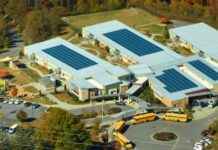K-12 facilities managers are facing significant challenges as they strive to maintain efficiency and cost savings in the wake of aging infrastructure and tight budget constraints. A recent survey conducted by Incident IQ, a workflow management platform designed for K-12 schools, sheds light on the priorities and strategies of facilities teams as they navigate these complex issues.
With the average age of U.S. school buildings approaching 50 years old, facilities managers are constantly balancing maintenance and repairs to address the need for replacements that may not always align with annual budgets. The survey reveals that facilities teams are placing a strong emphasis on reducing maintenance costs, enhancing efficiency, and transforming learning environments as their top priorities for the upcoming school year.
R.T. Collins, CEO of Incident IQ, acknowledges the crucial role that facilities managers play in ensuring that aging buildings remain functional for students and teachers. He emphasizes the importance of finding a balance between addressing immediate needs and implementing long-term solutions to improve operations. Collins highlights the growing trend of leveraging technology to achieve efficiency, cost savings, and valuable insights, noting that many teams are turning to tech solutions to meet the evolving demands of their roles.
According to the survey, while nearly half of respondents believe their current systems and processes are somewhat effective in managing their workload, there is a clear interest in investing in technology to enhance operational capabilities. Key considerations for facilities teams looking to streamline workflows and improve communication include Computer Maintenance Management Software (CMMS), mobile applications for staff, digital maintenance tracking, and automated scheduling systems.
The survey, commissioned by Incident IQ and conducted by Spaces4Learning, provides valuable insights into the challenges and priorities of K-12 facilities managers as they prepare for the upcoming academic year. The report delves into topics such as technology adoption, barriers to implementation, facilities request management, and data utilization for informed decision-making.
Strategies for Efficient Budgeting
One of the key strategies identified in the survey is the importance of efficient budgeting to address the unique needs of aging school buildings. Facilities managers are increasingly focused on finding ways to reduce maintenance costs without compromising the quality of services provided. By investing in technology solutions such as CMMS and mobile applications, teams can streamline their workflows, improve communication, and gain valuable insights into their operations.
Another important consideration for facilities managers is the revamping of learning environments to create spaces that are conducive to student success. By implementing digital maintenance tracking systems and automated scheduling processes, teams can ensure that repairs and upgrades are carried out efficiently and effectively. These improvements not only benefit students and teachers but also contribute to the overall success of the school.
Technology Adoption and Barriers
The survey highlights the growing interest in technology adoption among facilities teams, with a focus on overcoming barriers to implementation. While many respondents believe that their current systems are somewhat effective, there is a clear recognition of the need for tech solutions to enhance operational capabilities. By investing in CMMS, mobile applications, and digital maintenance tracking, facilities managers can improve communication, streamline workflows, and make more informed decisions.
However, barriers to technology adoption still exist, with some teams facing challenges in implementing new systems and processes. By addressing these barriers through training, support, and collaboration, facilities managers can overcome obstacles and successfully integrate technology solutions into their operations.
Conclusion
In conclusion, K-12 facilities managers are facing the dual challenges of aging infrastructure and budget constraints with a focus on efficiency and cost savings. By leveraging technology solutions and investing in innovative strategies, facilities teams can address maintenance needs, improve operational efficiency, and create learning environments that support student success. The survey conducted by Incident IQ provides valuable insights into the priorities and strategies of facilities managers as they navigate the complexities of managing school buildings in the coming academic year.


